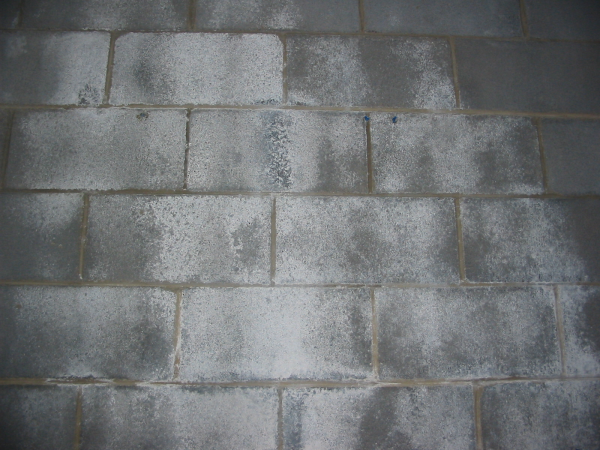Efflorescence. It’s the whitish powdery material that forms on the surfaces of masonry or concrete construction, and also it’s the white blush that can form on sealed concrete floors or concrete countertops. While it poses no threat structurally, efflorescence is an aesthetic nuisance that affects both interior and exterior concrete. This series of articles discusses why efflorescence occurs, how it can be prevented and how to deal with it if it does happen.
Efflorescence “growing” on the inside of a concrete block wall.
There are two kinds of efflorescence: primary and secondary. Primary efflorescence occurs when concrete bleedwater dries on the surface. Secondary efflorescence occurs when soluble mineral salts are leached out of cured concrete. This post will cover Primary Efflorescence.
Primary Efflorescence
Eliminating primary efflorescence begins before the concrete is cast, simply by using basic good concreting practices: Start with a concrete mix that uses well-graded aggregates, a low water-to-cement (w/c) ratio, and fly ash or other pozzolan as a partial cement replacement; use a water reducer to increase workability without adding extra water to the mix.
Extra water in the concrete makes it more porous, weaker, and more susceptible to shrinkage cracking. The extra water is an unwanted internal reservoir that can leach the salts out of the concrete. Concrete made with a w/c of around 0.45 will produce a strong, dense mix that’s unlikely to have excessive bleedwater.
Fly ash adds workability and replaces some of the cement. Since it’s a pozzolan, it consumes the calcium hydroxide produced during cement hydration. Calcium hydroxide, also known as free lime, is a key efflorescence-producing compound. Pozzolans consume the calcium hydroxide and produce calcium silicate hydrates, which make the concrete stronger, denser and less porous. This reduces the likelihood of efflorescence by shrinking capillaries and plugging the pores within the concrete.
Making good concrete is just the first step. It does no good to have a well-designed, low w/c ratio concrete if it’s not cured properly. Wet curing under burlap, plastic sheeting or curing blankets allows the concrete to gain strength and density during the critical early days after casting. In young concrete, the capillary and pore structure is open and well-connected. As the concrete cures, the pores and capillaries get filled in and closed off, yielding a dense, more impermeable matrix. Well-cured concrete inhibits water movement, and this is one important step to controlling primary and secondary efflorescence. If the concrete doesn’t allow moisture movement, the salts deep within the concrete can’t be leached out.
Conversely, concrete that dries out quickly soon after finishing is sponge-like, filled with cracks and interconnected pores that allow moisture to move into and out of the concrete. Rapid evaporation of moisture draws efflorescence-causing salts to the surface through the porous, micro-crack filled, weak concrete matrix. Not only will efflorescence happen, it will continue to happen because the concrete never had a chance to cure into a dense, solid mass.
Next post: Secondary efflorescence

